If you own a Roper washing machine, you want it to work efficiently and effectively. However, like any other appliance, washing machines can experience problems. Fortunately, many of these issues can be resolved with simple troubleshooting techniques. Here we will guide you through some of the most common problems that owners encounter and provide you Roper washing machine troubleshooting ideas to fix them.
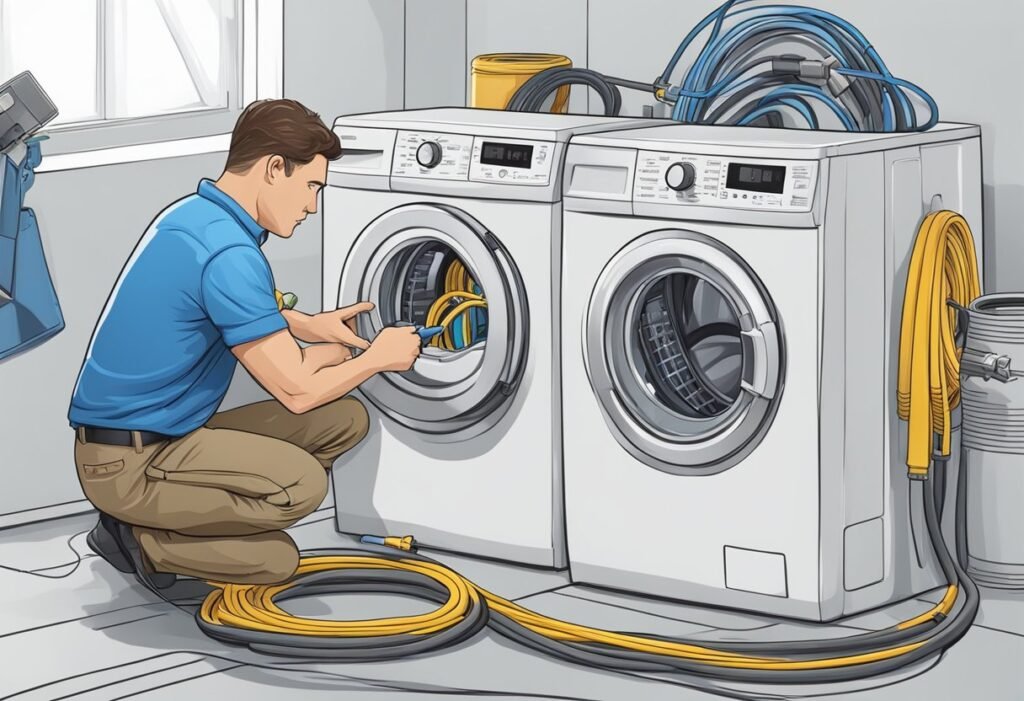
Table of contents
Basics Of Roper Washing Machine
If you are experiencing issues with your Roper washing machine, it is important to first understand the basics of your machine. This will help you troubleshoot any problems that may arise and ensure that your machine is functioning properly.
Model Identification
The first step in understanding your Roper washing machine is to identify the model number. This can usually be found on the back of the machine, on the inside of the door, or the control panel. Once you have identified the model number, you can refer to the user manual or online resources to learn more about your specific machine.
Control Panel Overview
The control panel of your Roper washing machine is where you can select the cycle, temperature, and other settings for your wash. Different models may have different control panels, but most will have similar options. Here is a brief overview of the common settings you may find on your Roper washing machine:
- Cycle Selector: This allows you to choose the type of wash cycle you want, such as normal, delicate, or heavy-duty.
- Temperature Selector: This allows you to choose the temperature of the water for your wash, such as hot, warm, or cold.
- Load Size Selector: This allows you to choose the size of your load, such as small, medium, or large.
- Start/Pause Button: This button starts or pauses your wash cycle.
- Delay Start Button: This allows you to delay the start of your wash cycle for a certain amount of time.
- Cycle Status Lights: These lights indicate the current status of your wash cycle, such as wash, rinse or spin.
Also Read: Easiest way to vent washer’s drain pipe.
Roper Washing Machine Common Problems & Troubleshooting
If you are experiencing issues with your Roper washing machine, don’t worry, you are not alone. Here are some common problems and solutions to help you troubleshoot your machine.
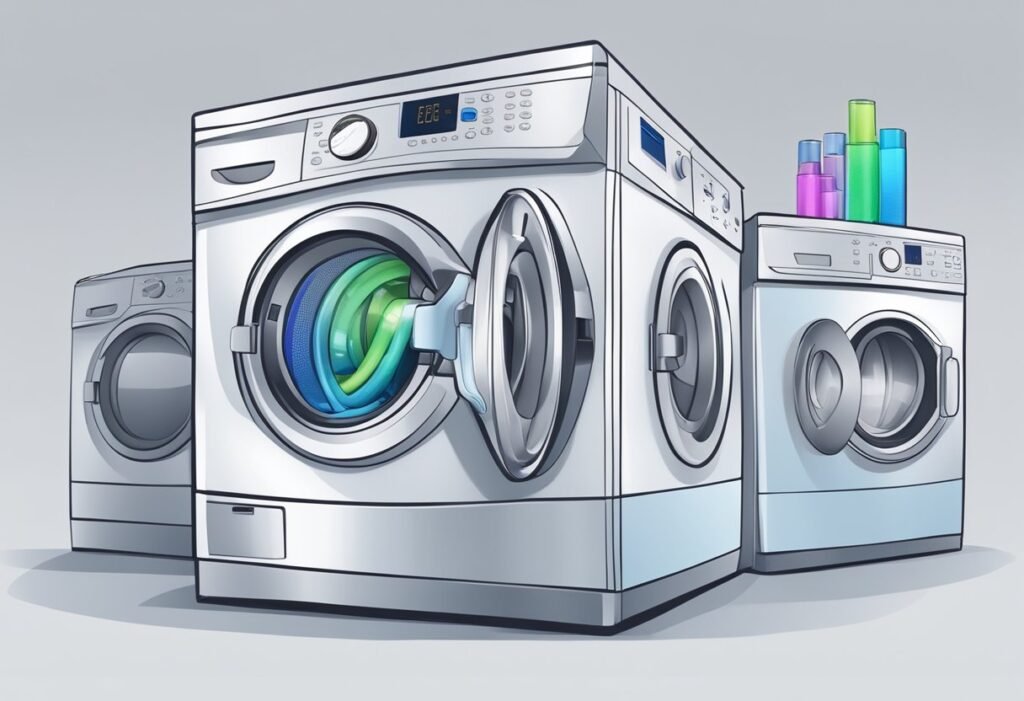
Machine Won’t Start
If your machine won’t start, it could be due to a power supply problem, a locked door, a water supply problem, a control panel problem, or a malfunctioning part. Check if your machine is getting enough power to switch on. If the power supply is not the issue, ensure the door is not locked, and the water supply is not interrupted. If all else fails, it could be a malfunctioning part, such as the main control board.
Water Not Filling
If your washer is not filling with water, it could be due to a clogged water inlet valve, a malfunctioning water level switch, or a broken water supply line. Check the water inlet valve for any clogs and ensure the water level switch is functioning correctly. If the water supply line is broken, it will need to be replaced.
Drainage Problems
If your Roper washer is not draining properly, it could be due to a clogged drain hose, a malfunctioning drain pump, or a damaged belt. Check the drain hose for any clogs and ensure the drain pump is functioning correctly. If the belt is damaged, it will need to be replaced.
Unusual Noises
If your washing machine is making unusual noises, it could be due to a loose drum, a malfunctioning motor, or a damaged belt. Check the drum for any looseness and ensure the motor is functioning correctly. If the belt is damaged, it will need to be replaced.
Cycle Irregularities
If your washer is not completing its cycle or is taking too long, it could be due to a malfunctioning timer, a clogged filter, or a damaged belt. Check the timer for any malfunctions and ensure the filter is clean. If the belt is damaged, it will need to be replaced.
Machine Vibrates or Shakes
If your Roper washing machine is vibrating or shaking excessively, it could be due to an unbalanced load or a malfunctioning suspension spring. Ensure the load is balanced and the suspension spring is functioning correctly. If the suspension spring is damaged, it will need to be replaced.
Remember to always consult the manufacturer’s manual or a professional technician before attempting to repair your washing machine.
Maintenance Tips For Your Roper Washing Machine
To keep your Roper washing machine running smoothly, it’s essential to perform regular maintenance. Here are some simple maintenance tips that you can follow to keep your washer in top condition.

Clean Washer
One of the most important things you can do to maintain your Roper washing machine is to keep it clean. Over time, detergent residue, dirt, and other debris can build up inside the machine, leading to unpleasant odors and reduced performance.
To clean your washer, start by wiping down the inside of the drum and the door seal with a damp cloth. You can also use a mild detergent or vinegar to remove any stubborn stains or odors. Be sure to clean the detergent dispenser and any other removable parts as well.
Inspect Hoses
The hoses that connect your Roper washing machine to the water supply can become worn or damaged over time, leading to leaks or other problems. To prevent this, it’s a good idea to inspect the hoses periodically and replace them if you notice any signs of wear or damage.
Check for cracks, bulges, or other signs of wear on the hoses. If you find any problems, turn off the water supply to the machine and replace the hoses immediately.
Check Filters
Many Roper washing machines have filters that can become clogged with lint, dirt, or other debris over time. To prevent this, it’s important to check the filters periodically and clean or replace them as needed.
Refer to your machine’s user manual to locate the filters and learn how to remove and clean them. In general, you can clean the filters by rinsing them under running water or using a soft brush to remove any debris.
Leveling the Machine
If your Roper washing machine is not level, it can cause vibration, noise, and other problems during operation. To prevent this, it’s important to check the machine’s level periodically and adjust it as needed.
Use a level to check the machine’s balance. If it’s not level, adjust the feet at the bottom of the machine until it’s perfectly balanced. This will help ensure that your machine runs smoothly and quietly.
Troubleshoot Your Roper Washer by Error Codes
If your Roper washing machine is displaying an error code, it can be helpful to know what the code means and how to troubleshoot the issue. Here are some common error codes and their interpretations:
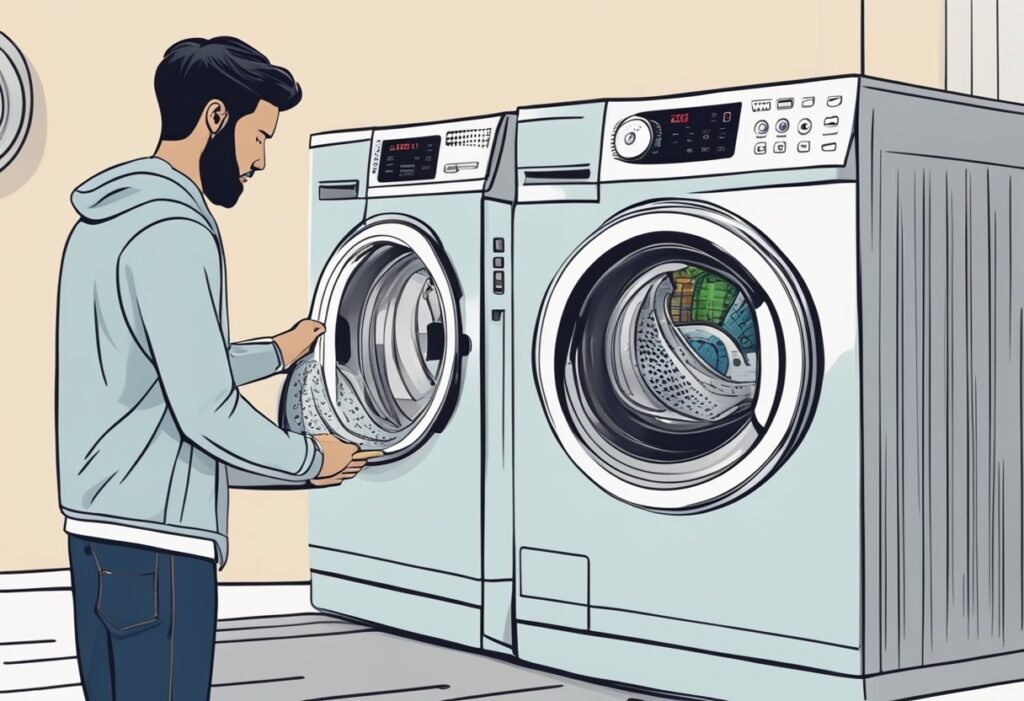
Error Code Interpretation
- F1 – This code indicates a problem with the machine’s primary control board. You may need to replace the control board to resolve the issue.
- F2 – This code indicates a problem with the machine’s user interface control board. You may need to replace the control board to resolve the issue.
- F3 – This code indicates a problem with the machine’s temperature sensor or heating element. You may need to replace the faulty part to resolve the issue.
- F5 – This code indicates a problem with the machine’s lid switch. You may need to replace the switch to resolve the issue.
- F6 – This code indicates a problem with the machine’s motor control board. You may need to replace the control board to resolve the issue.
- F7 – This code indicates a problem with the machine’s motor speed control board. You may need to replace the control board to resolve the issue.
- F8 – This code indicates a problem with the machine’s water level sensor or pressure switch. You may need to replace the faulty part to resolve the issue.
- F9 – This code indicates a problem with the machine’s door latch or lock. You may need to replace the faulty part to resolve the issue.
Reset Your Roper Machine
If your Roper washing machine is displaying an error code, you may be able to reset the machine to clear the code. Here’s how to reset the machine:
- Unplug the machine from the electrical outlet.
- Wait for 30 seconds.
- Plug the machine back in.
- Turn the machine on and see if the error code has cleared.
If the error code persists, you may need to troubleshoot the issue further or contact a professional for assistance.
Remember to always consult your machine’s manual for specific error codes and troubleshooting steps.
Also Read: Remove Mold from Rubber Seal On Washer.
Replacement Parts and Repair
If you need to replace a part in your Roper washing machine, it’s important to identify the correct part to ensure proper functioning of the machine. Here are some of the most common replaceable parts in a Roper washing machine:
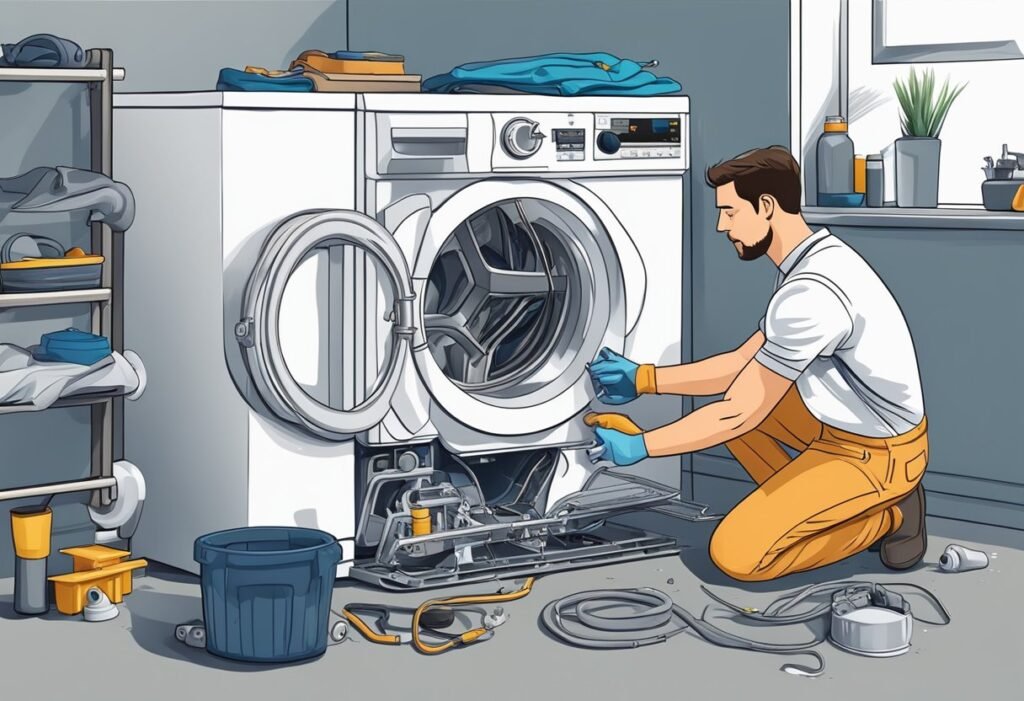
Identify Replaceable Parts
- Agitator Dogs: These are small plastic pieces that allow the agitator to move in one direction and lock in the other. If the agitator is not moving properly, it may be due to worn agitator dogs.
- Drive Belt: This belt connects the motor to the transmission and allows the drum to spin. If the belt is worn or broken, the drum won’t spin.
- Lid Switch: This switch prevents the washer from spinning or agitating when the lid is open. If the switch is faulty, the washer won’t start.
- Water Pump: This pump is responsible for draining the water from the washer. If the pump is clogged or faulty, the washer won’t drain properly.
Once you have identified the replaceable part, you can purchase the replacement part from a local appliance parts store or online retailer. Be sure to have the model number of your Roper washing machine when purchasing the replacement part to ensure compatibility.
DIY Repair Guidance
If you’re comfortable with DIY repairs, you can replace the part yourself. Most replacement parts come with installation instructions, but here are some general steps to follow:
- Unplug the washing machine and turn off the water supply.
- Remove the part that needs to be replaced by following the instructions provided with the replacement part.
- Install the new part by following the instructions provided with the replacement part.
- Reconnect any wires or hoses that were disconnected during the repair.
- Plug in the washing machine and turn on the water supply.
- Test the washing machine to ensure the repair was successful.
If you’re not comfortable with DIY repairs, it’s best to hire a professional to ensure the repair is done properly. Remember to always prioritize safety when working with electrical appliances.
Professional Assistance
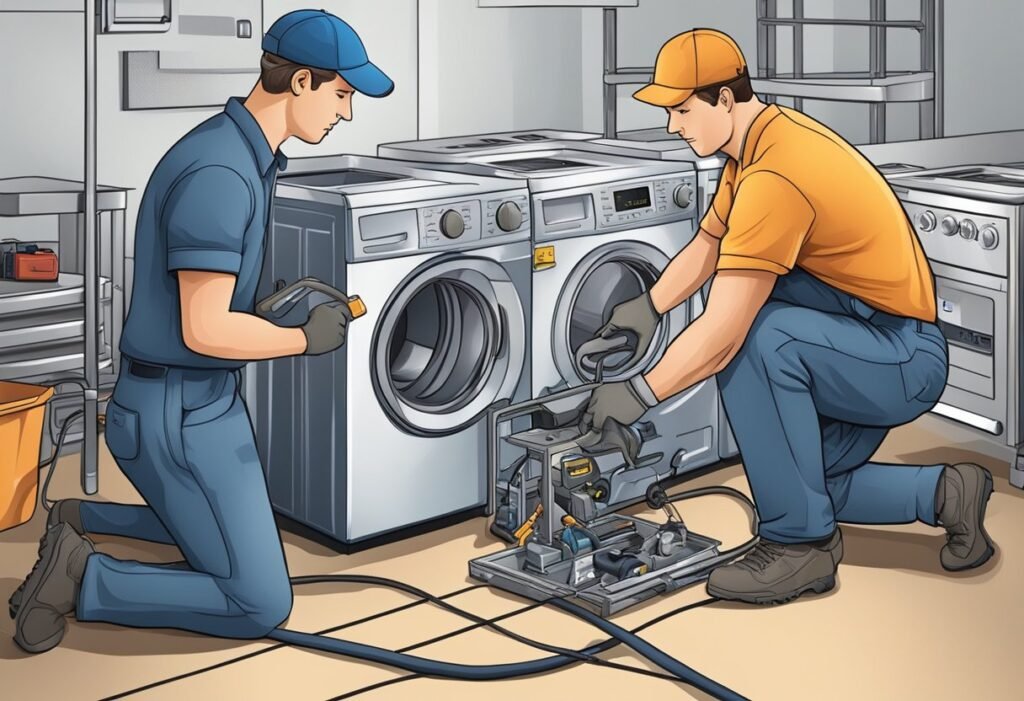
If you have tried troubleshooting your Roper washing machine and the problem persists, it may be time to call in a professional. Here are some instances where you should consider calling a technician:
When to Call a Technician
- Electrical issues: If you suspect that the problem is electrical, such as a faulty power supply or wiring, it is best to call a licensed electrician or a washing machine technician. Attempting to fix electrical issues yourself can be dangerous and may cause further damage to your machine.
- Mechanical issues: If your washing machine is making strange noises, leaking water, or not spinning properly, it is likely a mechanical issue. Attempting to fix these issues yourself can be complicated and may require specialized tools and knowledge. A washing machine technician can diagnose the problem and fix it quickly and efficiently.
- Error codes: If your washing machine displays an error code, it is best to call a technician. Error codes can be confusing, and attempting to fix the problem without proper knowledge can cause further damage.
Warranty and Service Information
If your Roper washing machine is still under warranty, it is important to contact the manufacturer or the retailer where you purchased the machine. Attempting to fix the machine yourself may void the warranty.
If your warranty has expired or if you do not have a warranty, you can contact a washing machine repair service. These services can diagnose the problem and provide a quote for the repair cost. It is important to choose a reputable repair service to ensure that the repair is done correctly and that you are not overcharged.
In summary, if you are unable to troubleshoot your Roper washing machine, it is best to call a professional. Attempting to fix the machine yourself can be dangerous and may cause further damage. If your machine is still under warranty, contact the manufacturer or retailer, otherwise, choose a reputable washing machine repair service.
Preventive Measures
To avoid frequent breakdowns and ensure the longevity of your Roper washing machine, it is essential to take some preventive measures. Here are some tips to help you keep your machine in tip-top shape.
Proper Usage Tips
Proper usage of your washing machine is crucial to avoid unnecessary wear and tear and prolong its lifespan. Here are some tips to help you use your Roper washing machine correctly:
- Load your washing machine correctly: Overloading your washing machine can cause strain on the drum and motor, leading to breakdowns. On the other hand, under-loading your machine can cause imbalance and affect the washing quality. Therefore, ensure that you load your washing machine according to the manufacturer’s instructions.
- Use the right detergent: Using the wrong detergent can cause damage to your washing machine’s drum and other components. Always use the detergent recommended by the manufacturer.
- Clean the machine regularly: Regular cleaning of your washing machine can help prevent the buildup of dirt, lint, and other debris that can cause clogs and damage to your machine. Clean the drum, the lint filter, and the detergent dispenser regularly.
Avoiding Common Mistakes
Avoiding some common mistakes can help you prevent frequent breakdowns and keep your Roper washing machine running smoothly. Here are some common mistakes to avoid:
- Overloading the machine: Overloading your washing machine can cause strain on the drum and motor, leading to breakdowns.
- Using too much detergent: Using too much detergent can cause clogs in your machine’s drain pipes and damage the drum.
- Neglecting regular maintenance: Failing to clean your washing machine regularly can cause the buildup of dirt, lint, and other debris that can cause clogs and damage to your machine.
By following these preventive measures, you can keep your Roper washing machine running smoothly and avoid frequent breakdowns.
FAQ
How can I troubleshoot a Roper washing machine that is not draining?
If your Roper washing machine is not draining, there are a few things you can check. First, make sure the drain hose is not kinked or clogged. If the hose is clear, there may be a problem with the drain pump or the lid switch. You can try manually advancing the timer to the spin cycle to see if the machine will drain. If it does not, you may need to replace the pump or lid switch.
What steps should I take if my Roper washer won’t fill with water?
If your Roper washing machine won’t fill with water, first make sure the water supply valves are fully open. You should also check the inlet hose screens for any debris or buildup. If the screens are clear and the valves are open, there may be an issue with the water inlet valve or the timer. You can try manually advancing the timer to the fill cycle to see if the machine will fill. If it does not, you may need to replace the valve or timer.
Why might my Roper washing machine stop during the wash cycle?
If your Roper washing machine stops during the wash cycle, it could be due to a few different issues. First, check the lid switch to make sure it is functioning properly. If the switch is working, there may be a problem with the timer or the motor. You can try manually advancing the timer to see if the machine will continue the cycle. If it does not, you may need to replace the timer or motor.
How can I enter diagnostic mode on a Roper washing machine?
To enter diagnostic mode on a Roper washing machine, you will need to press a specific sequence of buttons on the control panel. The exact sequence may vary depending on the model of your machine, so refer to the user manual for instructions. Once in diagnostic mode, you can run tests on various components of the machine to identify any issues.
What should I check if my Roper washing machine is not spinning?
If your Roper washing machine is not spinning, first make sure the lid switch is functioning properly. If the switch is working, there may be an issue with the motor or the belt. You can try manually advancing the timer to the spin cycle to see if the machine will spin. If it does not, you may need to replace the motor or belt.
How can I locate and replace the lid switch on a Roper washing machine?
To locate and replace the lid switch on a Roper washing machine, you will need to remove the control panel and the cabinet. The switch is typically located near the lid hinge. Once you have located the switch, you can disconnect the wires and remove the switch from the machine. Install the new switch and reassemble the machine. Refer to the user manual for detailed instructions and diagrams.



